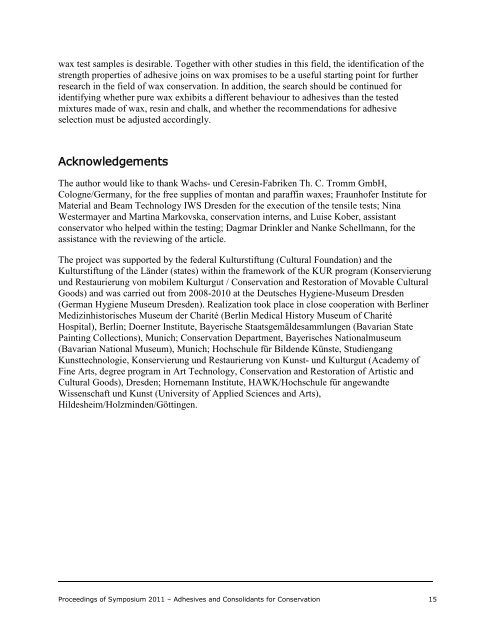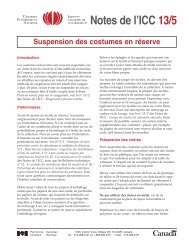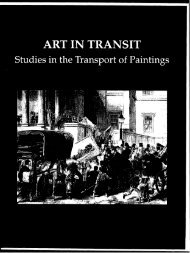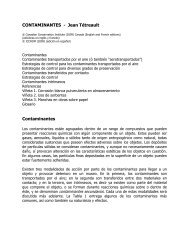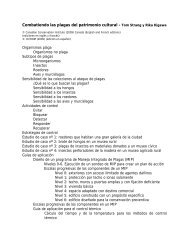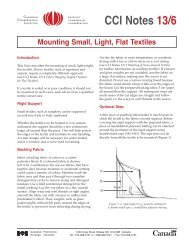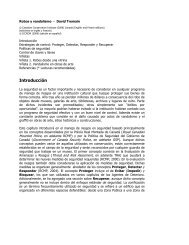Adhesives for Wax Artifacts - Institut canadien de conservation
Adhesives for Wax Artifacts - Institut canadien de conservation
Adhesives for Wax Artifacts - Institut canadien de conservation
Create successful ePaper yourself
Turn your PDF publications into a flip-book with our unique Google optimized e-Paper software.
wax test samples is <strong>de</strong>sirable. Together with other studies in this field, the i<strong>de</strong>ntification of the<br />
strength properties of adhesive joins on wax promises to be a useful starting point <strong>for</strong> further<br />
research in the field of wax <strong>conservation</strong>. In addition, the search should be continued <strong>for</strong><br />
i<strong>de</strong>ntifying whether pure wax exhibits a different behaviour to adhesives than the tested<br />
mixtures ma<strong>de</strong> of wax, resin and chalk, and whether the recommendations <strong>for</strong> adhesive<br />
selection must be adjusted accordingly.<br />
Acknowledgements<br />
The author would like to thank Wachs- und Ceresin-Fabriken Th. C. Tromm GmbH,<br />
Cologne/Germany, <strong>for</strong> the free supplies of montan and paraffin waxes; Fraunhofer <strong>Institut</strong>e <strong>for</strong><br />
Material and Beam Technology IWS Dres<strong>de</strong>n <strong>for</strong> the execution of the tensile tests; Nina<br />
Westermayer and Martina Markovska, <strong>conservation</strong> interns, and Luise Kober, assistant<br />
conservator who helped within the testing; Dagmar Drinkler and Nanke Schellmann, <strong>for</strong> the<br />
assistance with the reviewing of the article.<br />
The project was supported by the fe<strong>de</strong>ral Kulturstiftung (Cultural Foundation) and the<br />
Kulturstiftung of the Län<strong>de</strong>r (states) within the framework of the KUR program (Konservierung<br />
und Restaurierung von mobilem Kulturgut / Conservation and Restoration of Movable Cultural<br />
Goods) and was carried out from 2008-2010 at the Deutsches Hygiene-Museum Dres<strong>de</strong>n<br />
(German Hygiene Museum Dres<strong>de</strong>n). Realization took place in close cooperation with Berliner<br />
Medizinhistorisches Museum <strong>de</strong>r Charité (Berlin Medical History Museum of Charité<br />
Hospital), Berlin; Doerner <strong>Institut</strong>e, Bayerische Staatsgemäl<strong>de</strong>sammlungen (Bavarian State<br />
Painting Collections), Munich; Conservation Department, Bayerisches Nationalmuseum<br />
(Bavarian National Museum), Munich; Hochschule für Bil<strong>de</strong>n<strong>de</strong> Künste, Studiengang<br />
Kunsttechnologie, Konservierung und Restaurierung von Kunst- und Kulturgut (Aca<strong>de</strong>my of<br />
Fine Arts, <strong>de</strong>gree program in Art Technology, Conservation and Restoration of Artistic and<br />
Cultural Goods), Dres<strong>de</strong>n; Hornemann <strong>Institut</strong>e, HAWK/Hochschule für angewandte<br />
Wissenschaft und Kunst (University of Applied Sciences and Arts),<br />
Hil<strong>de</strong>sheim/Holzmin<strong>de</strong>n/Göttingen.<br />
Proceedings of Symposium 2011 – <strong>Adhesives</strong> and Consolidants <strong>for</strong> Conservation 15


